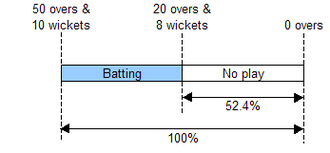Cricket is a game of uncertainties, influenced by factors ranging from weather conditions to interruptions in play. In situations where rain or other disruptions affect a limited-overs match, the Duckworth-Lewis-Stern (DLS) method comes to the rescue. This mathematical formula, named after its creators Frank Duckworth and Tony Lewis, with later revisions by Steven Stern, is used to calculate revised targets for the batting side in rain-affected or interrupted matches. In this article, we will delve into the intricacies of the DLS method, demystifying the mathematical wizardry that helps ensure fairness in such matches.

Read more.. Embracing Cricket Mania: The Impact of Odisha T20 in India
The Genesis of DLS
the Nevertheless, when adverse weather conditions or unforeseen interruptions truncate the playing duration, the task of determining a fair target for the team batting second becomes a complex enigma. It is precisely at this juncture that the DLS method assumes its pivotal and indispensable role.
The Core Principles
The DLS method operates on several core principles:
- Resources: It assesses the number of resources available to both teams, considering the total number of overs that can be bowled in the match.
- Wickets in Hand: The method takes into account the number of wickets lost by the team batting second. Fewer wickets in hand can make chasing a revised target more challenging.
- Overs Remaining: It calculates the number of overs remaining for the team batting second after considering the interruptions.
- Run-Rate: The method uses the current run-rate of the team batting second as a reference point.
The DLS Table
The heart of the DLS method lies in a complex table that is pre-calculated and tailored to specific formats of the game (ODIs, T20s). This table contains values that are used to adjust the target based on the factors mentioned above. The table considers the resources available at any given point in the match to provide a fair target.

Read more.. LPL Update 2023: A Thrilling Glimpse into the Lanka Premier League’s Latest Season
Calculating the Revised Target
When interruptions occur, the match officials refer to the DLS table to determine the revised target for the team batting second. The process involves intricate calculations that account for various scenarios, including the number of overs bowled, wickets lost, and the run-rate required.
The Impact of DLS
The primary objective of the DLS method is to level the playing field for both teams, irrespective of any disruptions; nonetheless, it has not been without its share of controversies. Critics argue that it can sometimes produce counterintuitive results, leading to matches where teams chasing a reduced target appear to have an advantage. Nevertheless, it remains an essential tool for match officials to maintain fairness in rain-affected games.
Conclusion
Cricket’s Duckworth-Lewis-Stern method may appear as a complex mathematical puzzle, but its purpose is straightforward – to provide equitable targets in situations where weather or interruptions threaten to disrupt the game. While it may not always satisfy everyone, it stands as a testament to the innovation and adaptability of the sport of cricket, ensuring that even in the face of uncertainty, the game can go on, and the thrill of competition remains intact.
Read more.. Gaming Innovation: From Computer generated Reality to eSports and Then Some

